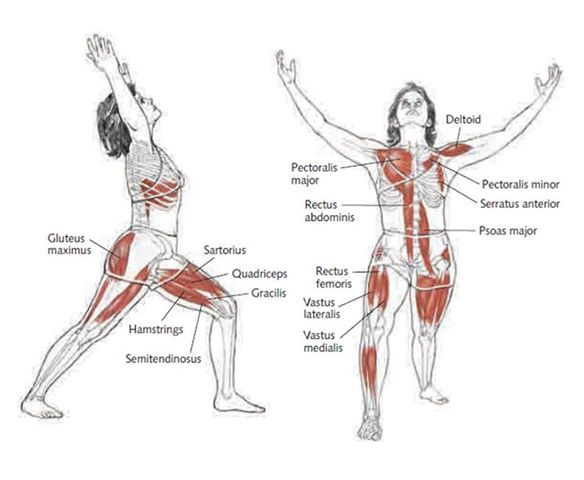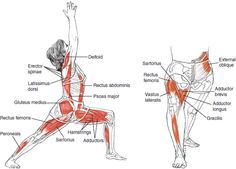Biomechanics: Virabhadrasana I (Warrior I Pose)

Figure taken from Kaminoff & Matthews 2012
The warrior I pose requires the practitioner to balance his
or her body's center of mass or center of gravity close to
both the lateral and horizontal center lines between the front
heel of the front foot and the toes of the back foot.
The center of mass is the
unique point at the center of a distribution of mass in space
where the weighted position forces relative to this point are
in equilibrium. Statistically speaking, the center of mass is
the mean location of a distribution of mass in space (Wikipedia.org).
Center
of gravity, on the other hand, is the
point in a body around which the resultant torque due to
gravity forces vanish (Wikipedia.org). Torque
is the tendency or ability of a force to rotate an object
around a pivot point, where this ability depends on not only
the magnitude of the force but also on where the force is
applied relative to the pivot point (Knight 2013).
Near the surface of the earth, where the gravity acts
relatively downward, the center of gravity and the center of
mass are the same (Wikipedia.org).
An individual's center of mass or gravity, is located in the
torso, typically along a line running across the shoulders,
parallel to the floor, for men, or across the hips and lower
abdomen for women. However, center of mass could be
located anywhere in between those two reference points,
depending on body geometry.
It is interesting to note that in the variation of warrior I with a longer and more narrow stance, shown in the figure below, the bend in the knee is such that the angle between the muscles in the thighs (hamstrings, quadriceps, gracilis, satorius, etc) and the muscles in the calves (peroneals) is close to 90 degrees.In warrior I and other lunging poses, the weight of the body (in relationship to gravity) creates the flexion at the knee and hip of the front leg - the muscles of the front leg are eccentrically contracting, which means they are active as they lengthen to keep from moving too far into flexion. The abductors in the front leg also need to be active eccentrically to level and orient the pelvis to the front leg and to maintain balance. if they shorten they can pull the front knee too far to the side or twist the pelvis out of alignment. In general, muscles become fatigued more quickly when they are close to their maximum working length, so it can take time to build stamina in these positions (Virabhadrasana I, longer stance variation, in figure below).
With a shorter stance in warrior I, the width of the base (at the feet) makes the balance easier, but the higher center of gravity in the shorter pose might actually make the balance feel more precarious for some. In a longer, narrower stance, it may be easier to balance because the center of gravity is lower. However, it may also be harder to balance because stance is narrower and the adductors then have to be effective at a greater length.
(Kaminoff & Matthews 2012)
 With a theoretical 2-dimensional (x and
y) axis system, set directly horizontal and
vertical to the floor,
respectively, the tensile forces are
distributed more in the thighs, directly along the x-axis,
in the longer stance variation, as compared to the first
version shown above where the angle made by the knee is
greater than 90 degrees.
With a theoretical 2-dimensional (x and
y) axis system, set directly horizontal and
vertical to the floor,
respectively, the tensile forces are
distributed more in the thighs, directly along the x-axis,
in the longer stance variation, as compared to the first
version shown above where the angle made by the knee is
greater than 90 degrees.